Jennifer Y. Chuong
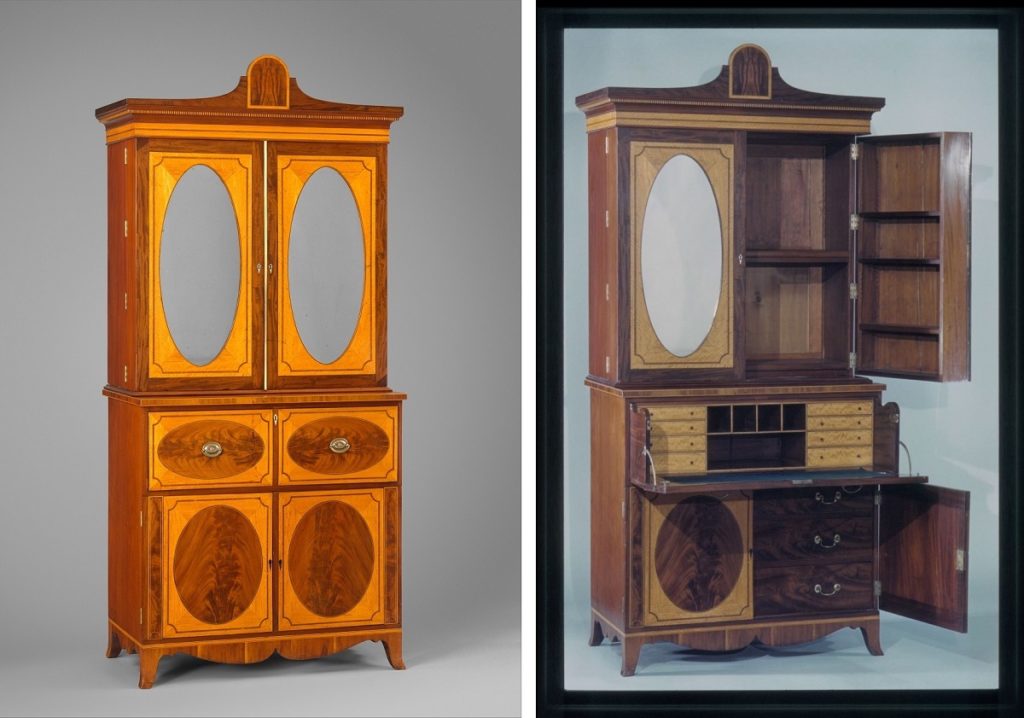
RIGHT: Fig. 1b. Interior of Fig. 1a. © Image courtesy of The Metropolitan Museum of Art, www.metmuseum.org.
Though its exterior is characterized by a straightforward neoclassical regularity (Fig. 1a), little about Philadelphia cabinetmaker John Davey’s Desk-and-Bookcase (1805-1810) is as it initially appears.[1] The mirrored doors are also the backs of bookshelves; the paired drawer pulls misleadingly adorn a single hinged panel; and the lower doors open to reveal three drawer fronts whose horizontal divisions controvert the structure implied by the vertically-hinged doors (Fig. 1b). The playful surfaces of the Davey desk are apt because the entire object is defined by surface play: it is made primarily of white pine and yellow poplar, and only veneered in mahogany and satinwood. That its panels are veneered, not solid, is emphasized by the high contrast between the two surface woods, and particularly by the two vertical bands of mahogany that visually reinforce the outer edges of the desk’s lower doors. Without them, we might read the satinwood as forming a ground into which the mahogany ovals are inlaid, but the presence of these two contrasting bands, framed with satinwood stringing so as to draw the eye, destabilizes our sense of figure and ground. Across the entire object, contrasting veneers work against the illusionary depth of figured wood, drawing the viewer’s eye back to the surface and emphasizing the planarity of the desk’s decoration.
Veneer’s superficial nature has long dogged its reception. Ever since Pliny the Elder described veneer as a means of “mak[ing] a single tree sell many times over,” the technique has most often been explained in economic and technological terms.[2] In existing analyses, the fashion for veneer in the late eighteenth century is generally framed as an expedient strategy that developed in response to mahogany’s increasing scarcity (hence, for example, the use of common, domestic woods for the carcase of the Davey desk).[3] The general perception of veneer has also been shaped by its Victorian disreputation: machine-cut veneers, quickly and easily slice into ever-thinner pieces, lent themselves to scamping, or the masking of “cheap and nasty” work, and thus became key targets of mid-nineteenth-century campaigns against surface deception.[4] However, statements by late eighteenth-century cabinetmakers like Thomas Sheraton, as well as cabinetmakers’ price books, demonstrate that, before the advent of steam machinery in the 1810s, veneer was just as, if not more, expensive than solid construction.[5] Furthermore, the particular use of veneer in this period—the framing and composition of figured wood so as to emphasize the individuality of its patterning and its status as veneer—suggests that veneering was not a furtive secret to be concealed, but rather a technique to be celebrated. In order to account for these archival and material statements, we need to revise our understanding of veneer’s motivation in the pre-industrial period: to see it not as the mere result of economic calculations, but rather borne out of a more complex interest in the appearance and meaning of figured wood.
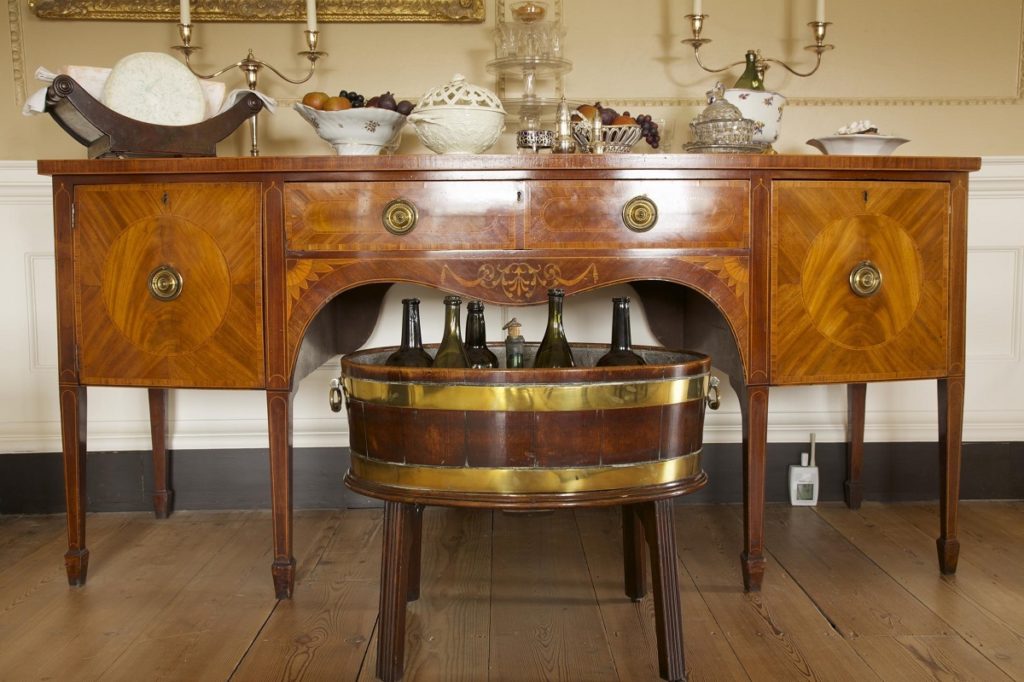
In this essay, I argue that the use of veneer in the early American republic was motivated by an aesthetic and philosophical interest in arboreal specificity: the peculiar twists and turns of the grain produced by a tree’s individual history. I trace the origins of this arboreal aesthetic to shifts in natural history description and examine its subsequent theorization in Picturesque writing. As evidenced by the use of veneers in late eighteenth-century English furniture objects, as well as corresponding illustrations in popular design books, many of the arguments that I put forward about veneer thus apply to the Anglo-American world writ broadly (Figs. 2 and 3). However, there is a crucial difference between the English and American contexts that impacts the meaning of veneer in these two places: the nature of their respective physical environments and, correspondingly, cultural understandings of those environments. In England, which had long struggled with timber scarcity, the Picturesque appreciation for Nature’s particular forms and adventitious beauty went hand-in-hand with an elite fashion for stewardship and afforestation.[6] In the United States, by contrast, trees were a much more dominant and uncertainly-construed presence.[7] Considered within this environmental context, Americans’ interest in the particular beauty of figured woods takes on a more complicated, darker cast than that of the English.
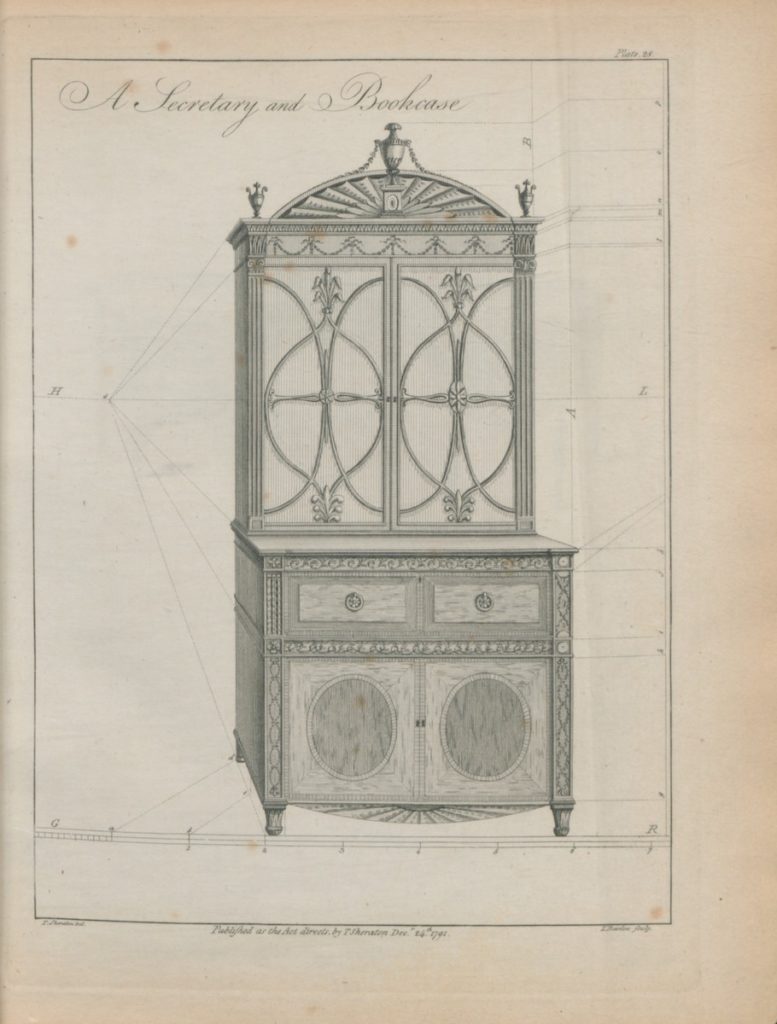
Carving Versus Slicing
The intricately-carved forms of the Chippendale-style furniture that preceded the rise of veneer in the late eighteenth century were made possible by the unusually dense, homogeneous grain of plain mahogany, which allows the woodworker to wield his or her knife with an unusual amount of freedom.[8] Chippendale furniture has thus long enjoyed a privileged position within Anglo-American decorative arts because of the intimate relationship it sponsors between form and matter, which has been associated by modern commentators with a “truth to materials” aesthetic.[9] However, the “truth” of this material property is more complicated than it initially seems, because plain mahogany’s accommodating nature allows the woodworker to idealize or abstract the wood’s materiality.[10] The radical transformation of rectilinear plank into highly modeled form suggests a conception of mahogany as being essentially similar throughout its extents—something like a block of fine marble or, as one present-day cabinetmaker describes it, a piece of hard chocolate: in other words, something whose texture and other physical properties are isomorphic across the whole.[11]
It is important to note that Chippendale-style furniture objects are not made out of plain wood exclusively: figured surfaces do appear, often to great effect. In general, however, the grain-patterning is looser and softer in appearance (and therefore easier to work) than those used in veneered objects. Moreover, when they appear in sculpted forms, figured woods are primarily used as something like a drawn design that emphasizes the carver’s art. In some cases, this subordination of the wood to the carving knife becomes a wholesale subordination of the material to the maker’s vision, as when (according to William Dunlap) the sculptor William Rush “used to say it was immaterial what the substance was, the artist must see distinctly the figure in the block, and removing the surface was merely mechanical.”[12] In this conceptual schema, a piece of plain mahogany exhibiting variations from the norm is just that—a departure from an ideal.
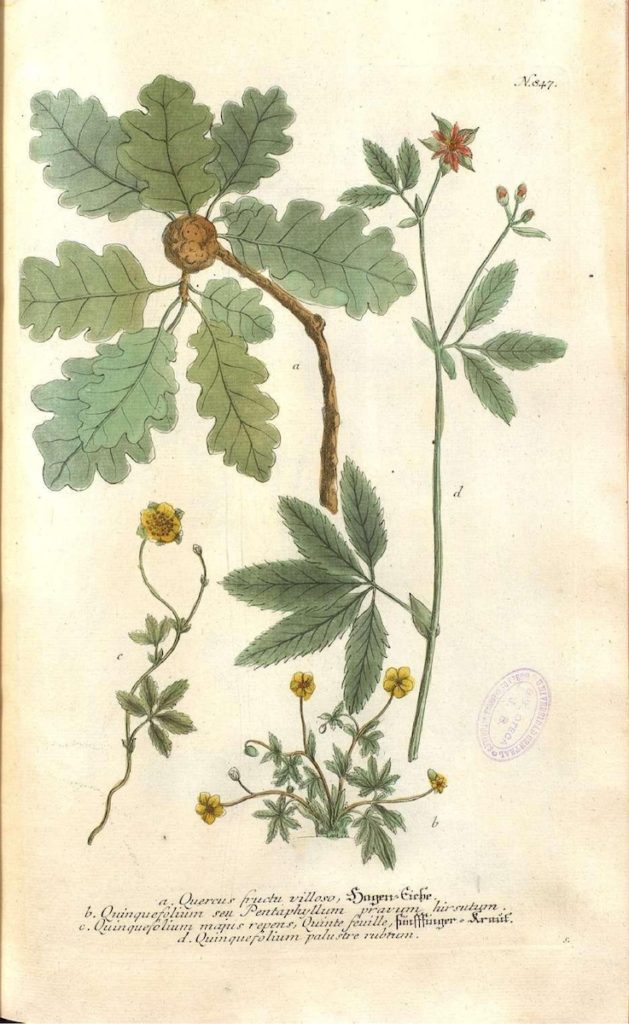
Such a schema accorded well with Grand-Style aesthetic theory, which, following Sir Joshua Reynolds, prized general ideals above material particulars. In a letter to The Idler in 1759, Reynolds compared the Naturalist’s search for general form among many instances of blades of grass, or leaves of trees, to the Painter’s search for general beauty among many individuals. Reynolds proposed a Platonic split between appearance and essence, placing on one side “the accidental blemishes and excrescences which are continually varying the surface of nature’s works,” and, on the other, “the invariable general form” that was Nature’s true intent.[13] Picking up on the artist’s reference to natural history practice, Lorraine Daston and Peter Galison have argued that Reynolds, like the naturalist Linnaeus, operated within a larger epistemological mode that they call “truth to nature.”[14] Linnaean-influenced natural histories thus illustrate species with a representation of an ideal type, rather than depictions of particular specimens (Fig. 4). And while a cabinetmaker of course has to contend with an actual, specific piece of wood, the mid-eighteenth-century preference for plain mahogany, and the exuberant forms that can be carved from it, can be understood as being motivated by a similar interest in the general, rather than particular, nature of materials. In a Chippendale-style chair from around 1760, for example, any piece of good, plain mahogany could be used to create any of the elaborately carved elements that make up its form (Fig. 5).
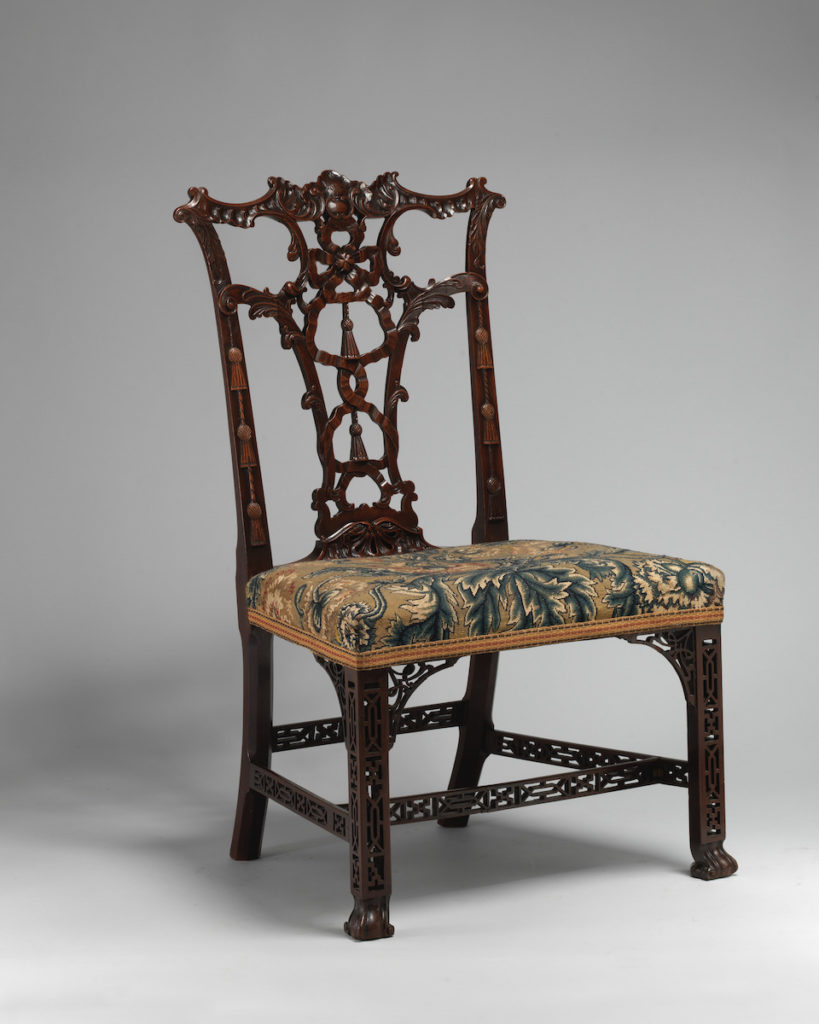
In the second half of the eighteenth century, natural historians, moving away from the generic descriptions of Linnaean taxonomy, began to attend more closely to the ways in which environments affect the shapes and properties of individual trees.[15] The Jamaica-based naturalist Edward Long noted, for example, that in contrast to mahogany grown in low, moist land, “what grows in rocky ground is of small diameter, but proportionably of closer grain, heavier weight, and more beautifully veined.”[16] Besides noting the variation exhibited by different individuals of the same species, aestheticians and naturalists began to attend to the differences that can exist within a given tree. By the last quarter of the eighteenth century, authors and artists were highlighting the beauty of aged trees’ strange and irregular forms, ultimately giving rise to a fashion for tree portraits (Figs. 6-7).
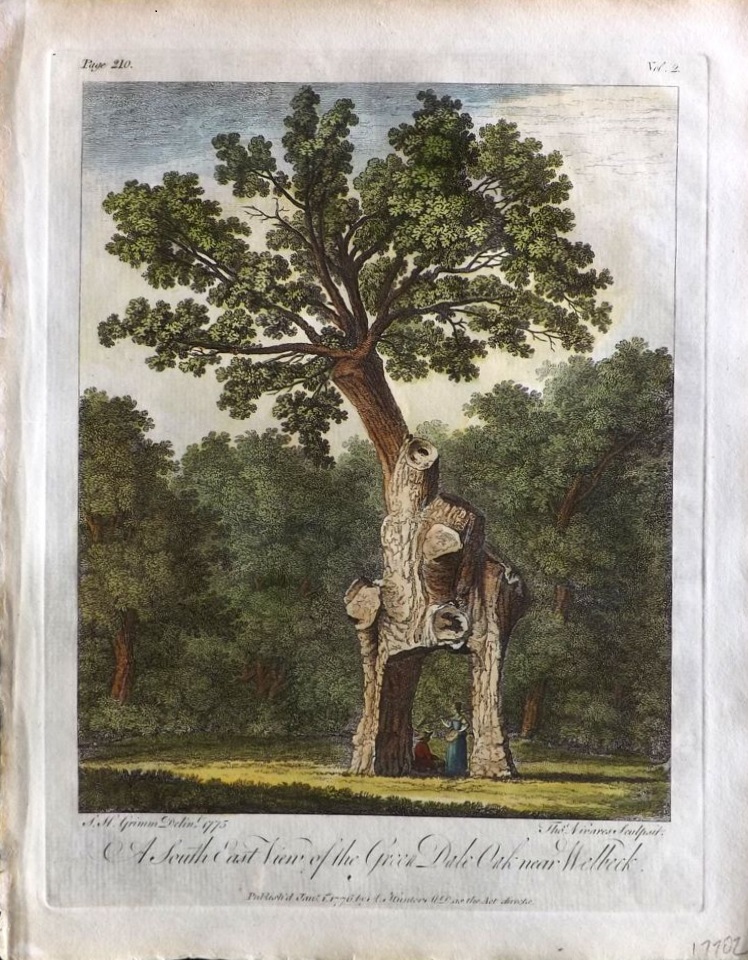
The Reverend William Gilpin theorized this interest in his Remarks on Forest Scenery (1791), observing that trees are remarkable because of their capacity for differentiation. Though Gilpin, like Linnaeus, recognized the basic similarity of a tree species’ parts (its leaves, seeds, blossoms, and sprays), he placed a greater priority on the fact that the “larger parts” of the tree, “from which the most beautiful varieties result, are wholly different.” One never sees “two oaks with an equal number of limbs, the same kind of head, and twisted in the same form.”[17] While some of this variety is intrinsic to tree morphology, Gilpin also emphasized trees’ constitutive relationship with their environment. “Great beauty” was added to trees by adventitious things, including accidents of location, weather, injury, and disease.[18] Such beauty was found not only in the tree’s altered form, but in its surfaces, both interior and exterior. In a notable recuperation of Reynolds’s disparaging term, Gilpin repeatedly used the word “excrescences” to describe not only the veins of figured knobs and burls but also mosses and other surface growths, all of which he praised for their contributions to a tree’s beauty.[19] Of the maple, for example, Gilpin noted that “the veins of these excrescences … [are] so variegated, that they exceed the beauty of any other wood.”[20]
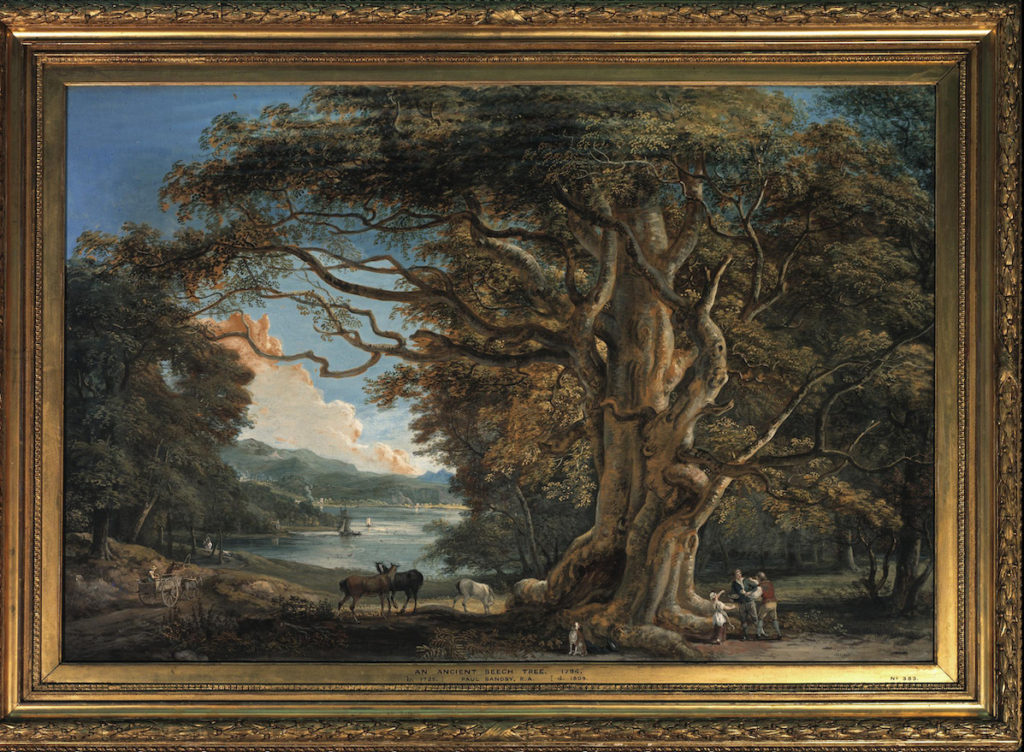
Gilpin’s appreciation for the beauty of figured wood may well have been primed by the new kinds of furniture objects that began to proliferate in the 1770s. In its earlier stages, the mahogany trade had been shaped by material efficiency.[21] Focusing on the demand for long, homogenous timbers (equally good for shipbuilding and table-making), merchants harvested the portion of the tree that was easiest to log and ship: the straight portion of the trunk.[22] By the 1760s, however, a new demand emerged for the irregularly-grained pieces of wood located in the tree’s base, the branching upper end of its trunk, and the burls (deformed growths) that form on the trunk and branches. The figured wood from these parts of the tree required new practices and calculations on the merchant’s part: they were often more difficult to harvest; their irregular shapes meant wasted space in the ship’s hold; and, above all, the value of any given flitch [a piece of wood intended for resawing] remained unknown until it was sawn open at the port of sale.[23]
Unlike plain mahogany, whose virtue lay in its selfsameness, both within and between pieces, figured wood was valued for the particular qualities of its appearance—qualities that were not, however, revealed until the merchant had already invested significantly in a given piece of wood. Far from multiplying the merchant’s pre-determined profits, it seems that the opposite is true: the multiplication of sellable surface was a necessary counterbalance to the higher risk involved in figured wood’s importation. In this way the very form of veneer can be understood as a re-stabilization of figured wood’s unstable value.
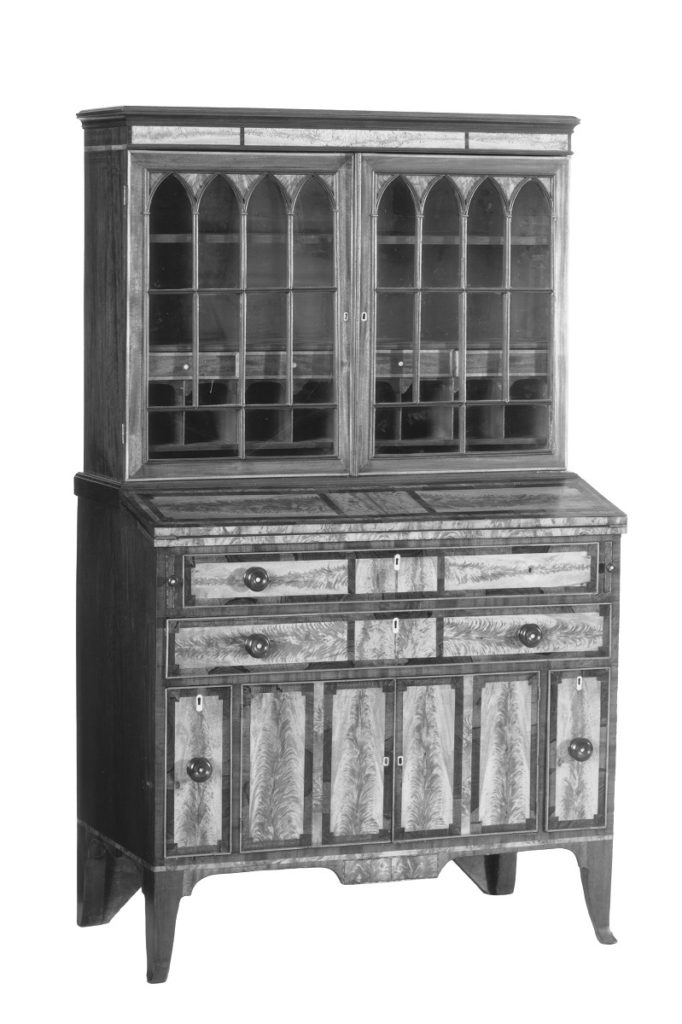
Veneer furniture put its valuable material to good, strategic use. Because figured wood is made up of fibers that are short and variously-oriented, it is difficult to carve and structurally unsound. By slicing the flitch with repeated, straight cuts, veneer-sawyers maximized their chances of creating usable material; and by mounting the fragile veneers onto more homogeneous substrates, cabinetmakers showcased the remarkable patterning of figured woods while compensating for their structural instability. Moreover, American cabinetmakers from the late eighteenth and early nineteenth centuries went to special lengths to celebrate the variation featured in each piece of figured wood. For objects from both earlier and later periods than the one under discussion, veneers were usually chosen for their consistent color and pattern, such that they could be applied either to create intricate marquetry designs or to give an overall surface texture to an object. On the Davey desk, by contrast, the oval mahogany veneers are presented in such a way as to highlight each veneer’s individual appearance. The large veneers are set off by contrasting satinwood surrounds, and their paired arrangement invites the viewer to examine the similarities and differences between each pair (see Fig. 1a). The invitation to perceive difference is heightened by the fact that each pair of veneers was cut into identical ovals, set into identical rectangular grounds, and embellished with identical frames of stringing (and further embellished, in the case of the middle panels, with identical brass drawer pulls).[24]
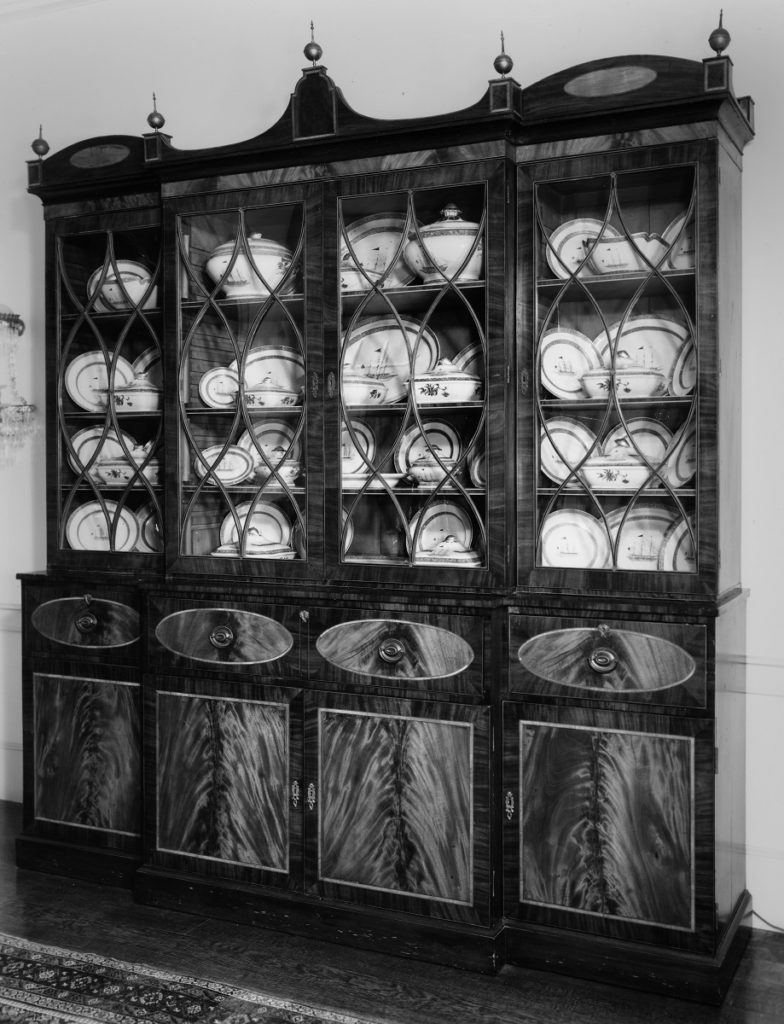
Against these skilled productions of formal repetition, the veneers’ variations in pattern and color are all the more striking. In this regard the Davey desk is exemplary: early American cabinetmakers often used relatively large pieces of veneer in regular arrangements that help call attention to their differences. Framed by contrasting banding or stringing, which pictorializes the figured grain, each slice is turned into something like a unique, if partial, portrait of the tree (Figs. 8-10). Thus veneers, even though they do not provoke or enable virtuosic acts of material intervention (i.e., carving), nonetheless evidence a close attention to, and engagement with, another aspect of trees’ materiality: the unique patterns of their grain.
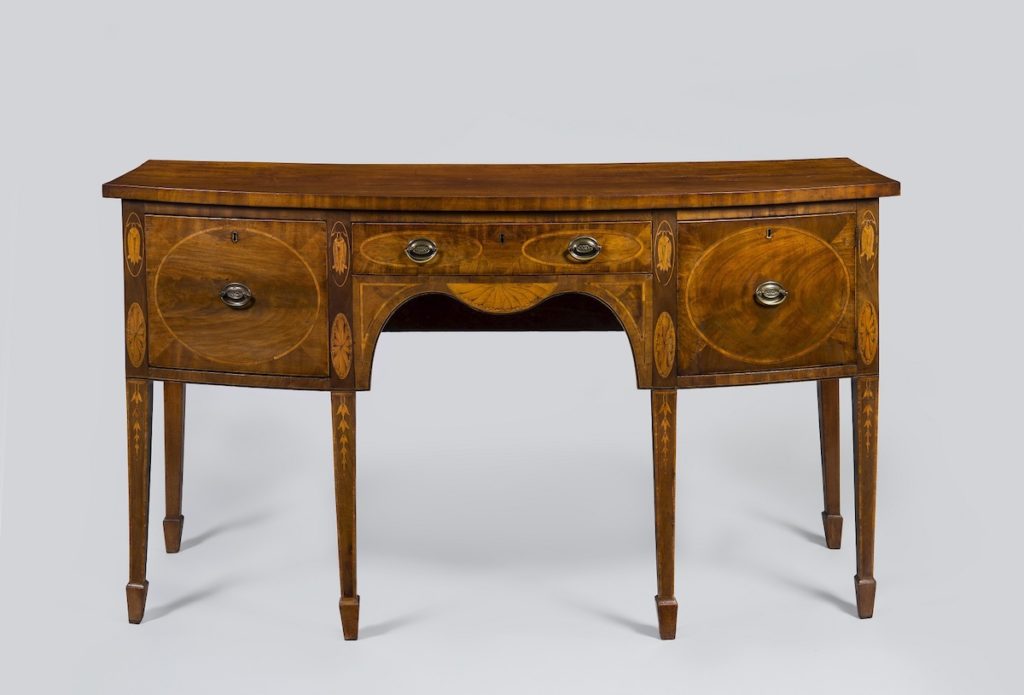
An Adventitious Beauty
Why did American cabinetmakers compose veneers with such attention to their individuality? They may have been motivated by the same aesthetic interest that led Gilpin to praise the adventitious beauty of trees in Remarks on Forest Scenery. Gilpin’s observation that adventitious beauty often derives from injury or disease points to another key aspect of the Picturesque valuation of trees: an appreciation for the difference or singularization of the tree as it develops over time (Figs. 11a-11b). Throughout Remarks, Gilpin praises older trees, whose “different modes of growth—the swelling of their roots—the habits they contract from wind—their ramification—their lateral branches, and other accidental circumstances introduce endless varieties among them.”[25] In other words, adventitious beauty resulted from a tree’s eccentricity and was a product of its ongoing relationship with a dynamic environment.
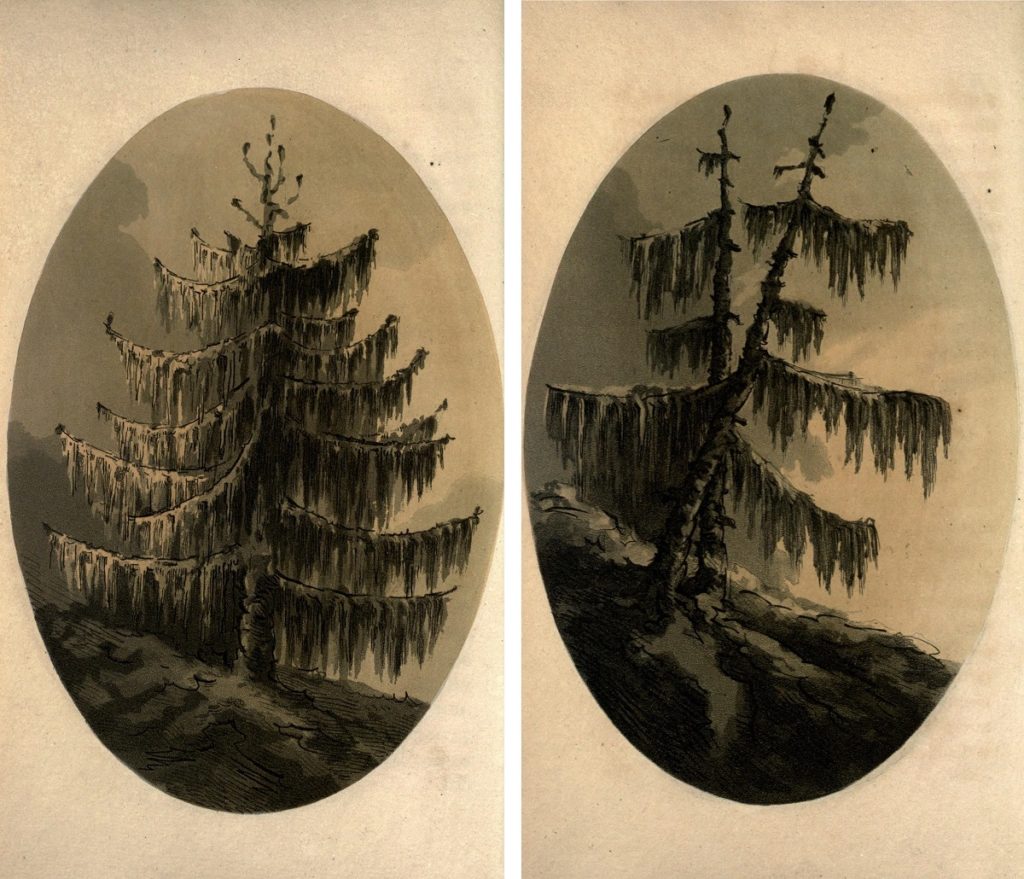
Along similar lines, the shift from “external” Linnaean natural history to the study of anatomy renewed an interest in tree rings as historical records.[26] The knowledge that tree trunks expand annually by concentric layers had long been commonplace, but it was not until the mid-eighteenth century that natural historians realized that the rings associated with harsh winters are noticeably thinner, leading Linnaeus to describe tree rings as “the chronicles of winters” and paving the way for the modern science of dendrochronology.[27] In 1833 the American scientist Alexander Twining would publish an animated report in which he described his realization that, among a large lot of hemlock timber, “every tree had preserved a record of the seasons, for the whole period of its growth.” If a slice were taken from a tree, it might be “smoothed on one side by the plane, so as to exhibit its record, to the eye, with all the distinctness and neatness of a drawing.”[28]
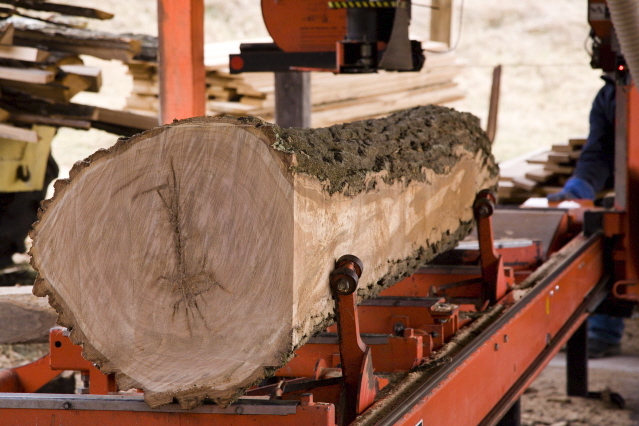
While there is a suggestive resonance between Twining’s cross-cut sections and the longitudinal, or plain-cut, veneers that typically adorn early American furniture (and which surely would have been familiar to a nineteenth-century commentator), there are also crucial differences between these two types of “drawings” or analytical surfaces (Fig. 12). As Twining pointed out, the value of the cross-cut section lay in the fact that “every tree told the same story.”[29] A cross-cut slice, especially one taken through the trunk, is, like the plain wood from the same area, the most generic portion of the tree, and it thus allows easy comparison between trees. But a cut through the “excrescences” and other formal nodes introduces so many idiosyncratic features that it resists the use of the slice as a representative sample. While a tree’s rings illustrate its general response to environmental conditions—the shared changes wrought in a community by common phenomena—a piece of plain-cut veneer, sliced from a branching node or a diseased burl, asserts the individuality of the tree, the peculiarity and particularity of its specific reaction to phenomena.
The fascination with the particular appearance of trees led to two conflicting attitudes: one which sought to decipher and analyze the tree’s grain, and another which was seduced by its mystery. On the one hand, Picturesque authors like Gilpin, as well as scientists like Twining, valorized wood-grain as a “record” or archive of natural events, whose form could be read or otherwise interpreted. But when it came to figured grain, authors acknowledged that its appearance often exceeded human analysis. In a goodly number of the North American species that the French naturalist François André Michaux described as possessing beautiful grain, he emphasized the role that happenstance played in their interesting appearance. Of the Red Flowering Maple, for example, he noted that “it sometimes happens that in very old trees, the grain instead of following a perpendicular direction, is undulated … This singular arrangement, of which I am able to assign no cause, is never witnessed in young trees [emphases added].”[30] Similarly, Michaux’s emphasis on the role of chance in his descriptions of the knobs of the Common European Elm as “exhibit[ing] very diversified accidents in the arrangement of the fibre,” or of the wood of the Sugar Maple as displaying “accidental forms in the arrangement of the fibre, of which cabinet-makers take advantage for making beautiful articles of furniture,” illustrate the extent to which formal disorder and causal obscurity were intertwined.[31]
This sense of mystery contributed to the aesthetic interest of figured wood. In contrast to the classical tradition of mirabilia, which delighted in the recognizable images of animals, faces, and other entities that were sometimes found in the patterned textures of natural materials, Gilpin argued that
The roots, and veins of wood, and stone, are much more beautiful, when they are wreathed in different fantastic forms; than when they seem to aim at any exact figures. In the former case they leave the imagination at liberty to play among them; which is always a pleasing exercise to it: in the latter, they are at best awkward, and unnatural likenesses; which often disgust the picturesque eye; and always please it less, than following it’s [sic] own fancy, and picking out resemblances of it’s [sic] own.[32]
Instead of focusing on what wood veins resembled, late eighteenth-century viewers were inclined to understand them as historical deposits whose visual splendor, as Gilpin points out, does not cohere in recognizable imagery. In other words, figured wood’s inexhaustible character expanded the possibilities of apprehension, rather than focusing it on a single image.
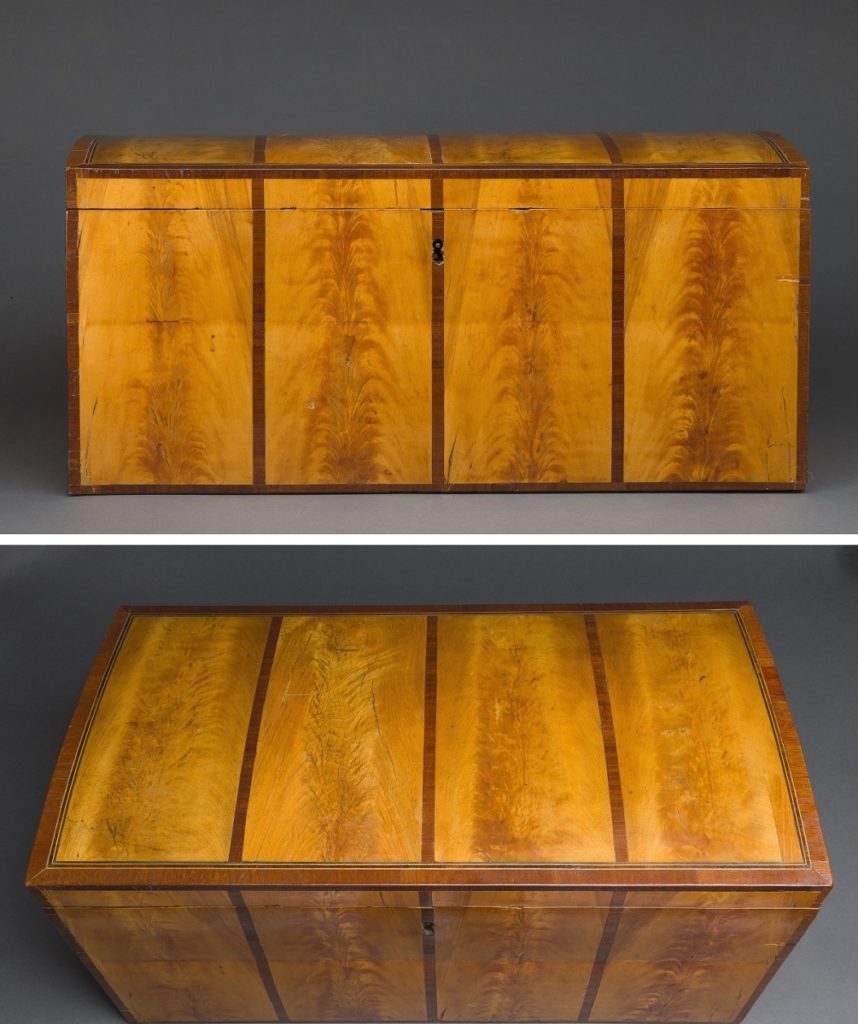
RIGHT: Fig. 13b. Front view of Fig. 13a. © Image courtesy of Winterthur Museum.
Moreover, American veneer objects often demonstrate how an ambition towards total control is undercut by the visual and material intransigence of the tree. In a veneered trunk from about 1790-1810, the veneers unabashedly display the variability of pattern that can be found within a given flitch (Figs. 13a-13b). Even as their shared coloration and dimensions announce the common origin of the birch veneers that make up the trunk’s exterior, the complex three-dimensional form of the grain, transformed by the veneer-saw into a series of unique, two-dimensional figures, produces arrhythmical patterns. Whereas the veneer figure seems to shift gradually across the four veneers that make up the trunk’s front, for example, the right two veneers on the trunk’s lid are abruptly different from the left two, giving the overall patterning a truncated syncopation. Alternatively, reading across the veneers from top to bottom, so to speak, we note the greater similarity between four rightmost panels, which is decidedly absent from the four panels to their left. These continuities and disjunctions assert the wood’s agency by thwarting attempts to reconstruct the three-dimensional form of the grain, emphasizing instead the idiosyncrasy and individuality of each slice of wood.
A Nation of Trees
So far I have focused on the rise of figured veneer as a transatlantic phenomenon. However, there was a particular edge to the American use of veneer that did not pertain in England. This edge derives from a surprising juxtaposition of behaviors: an elevation of individual trees as individuals, unique subject-like beings whose inimitability and ultimate mystery was proclaimed by the particular use of veneers in American furniture, on the one hand; and, on the other hand, by the massive deforestation that was simultaneously taking place as American settlers expanded westward. In this regard, it is important to note that while most of the examples illustrated in this essay are luxury objects featuring imported veneers like mahogany and satinwood, period texts like Michaux’s Sylva attest to the appreciation and use of figured veneers sliced from domestic species, especially those of birch, maple, and elm (see Fig. 13a-b).
This paradoxical condition was unique to the early American republic. By the late eighteenth century, England had been defined by a severe timber shortage for at least a century. The rise of the Picturesque admiration for trees should thus be understood, as Stephen Daniels and others have noted, as part of a larger valuation of trees “as signifiers of property and wealth, of nature and beauty, of age and senescence and of British freedoms contrasted to continental tyranny and abstract systems.”[33] Crucially, the aesthetic interest in trees went hand-in-hand with a concrete, material valuation of trees. The period between 1750 and 1850 was one in which a widespread concern over the shrinking English woodlands was combatted not only by philosophical and empirical attention to trees, but by physical projects of afforestation. In this regard, the economical use of veneers went hand-in-hand with a broader interest in preserving valued trees.
In contrast, the dense forests of America’s Eastern seaboard had shaped both its image and its physical settlement in a more ambiguous manner. While the forested landscape posed an immediate obstacle to settlement and agricultural cultivation, it also promised abundance, both by indicating the fertility of the underlying ground and by offering a seemingly-endless source of timber and other wood-based products (most notably potash) for colonial development.[34] In the years following the Revolution, a newly-expanded geopolitical context ensured that forests remained at the fore of American consciousness—both as crucial material resource and as hindrance to the unprecedented degree of expansion, clearing, and settlement that defined the period.[35]
The ubiquity of trees, simultaneously obstacle and resource, hastened their destruction. This in and of itself would not be surprising. What is surprising is that this destruction took place alongside the rise of a fellow-feeling for trees. An especially striking example is found in a 1782 letter published in the Pennsylvania Gazette, which purports to provide an account of an event that had occurred during a meeting of the United States Continental Congress to discuss a bill that proposed the felling or removal of all trees from the city of Philadelphia. In the midst of the debate (so the letter recounts), a voice, resonant but strangely wooden, had spoken out above the human delegates’ heads. An architectural capital, one of several crowning the wooden columns which punctuated the room’s walls, demanded the right to speak on behalf of its “numerous race, whose venerable ancestors gave the name of Penn’s Sylvania to this State”—in other words, the trees whose fate was being debated. Though the column’s request was initially repudiated on account of its being a “wooden member” and a “block-head,” the column persisted, firmly replying “that he was not only a member of the House, but one of its principal supporters; in as much as they could never make a House without him.”[36] Ultimately winning the right to speak, the column went on to deliver an impassioned entreaty for the political rights of trees, and indeed of all entities, down to stones and moss, who, no less than humans, deserved recognition, protection, and representation.
In her discussion of early Americans’ awareness of the “vibrant materiality” of trees, Laura Turner Igoe uses this editorial by “Silvester” (the pseudonym adopted by human delegate Francis Hopkinson) to demonstrate a perceived connection between wooden objects and the living trees from which they originated; as well as the ways in which respect and appreciation for trees paradoxically flourished in the midst of their destruction.[37] But what was it about trees that garnered them this particular respect? Another way of asking this question is: why did a tree (column), rather than a stone, speak out? One answer is that the Assembly Hall, like nearly everything else in early America, was made primarily of wood; and, perhaps rightfully for a democracy, greater presence prompted greater representation. Moreover, as Wendy Bellion has argued, trees—especially in columnar forms—have a specifically American history of being imbued with a human-like agency in contests over political representation.[38]
There is, however, another way of answering this question, which follows from the fascination with the particularity and mystery of figured wood that we have been examining. Waxing eloquent in his argument for the fundamental similarity of all entities, from the stone to the angel and “an infinite series of beings, of whom you know nothing,” the column proclaimed: “The superiority which man hath assumed over what he calls the irrational and inanimate creation, is a superiority only founded in their own pride and ignorance of our nature and faculties.”[39] Though the column identifies ignorance as a key barrier to an appreciation of trees’ subject-like nature, ignorance might also be understood as a key means by which trees become endowed with subject-like qualities. What veneer furniture objects evidence, in combination with contemporaneous descriptions emphasizing the accident and unknowability associated with such figured wood, is precisely the deep mystery of wood’s complex figuration, which individuated each tree and facilitated a perception of them as subject-like entities.
It is difficult to read Hopkinson’s words and not think of the other entities who would have been characterized as “irrational and inanimate,” or at least less humanly rational and animate than the white male delegates whom the column addressed: enslaved persons, indigenous persons, and women, to name just a few. In casting the broadest possible net over the entities that should qualify as “beings”—stone, moss, plants, polypus, oyster, ape, man, angel, etc.—the column (and Hopkinson) neatly overlooked the knotty problem of gradation within the human category. More cynically, one might read Hopkinson’s editorial as an argument for a radical reordering of the Great Chain of Being, in which trees are elevated above certain categories of less-worthy humans.
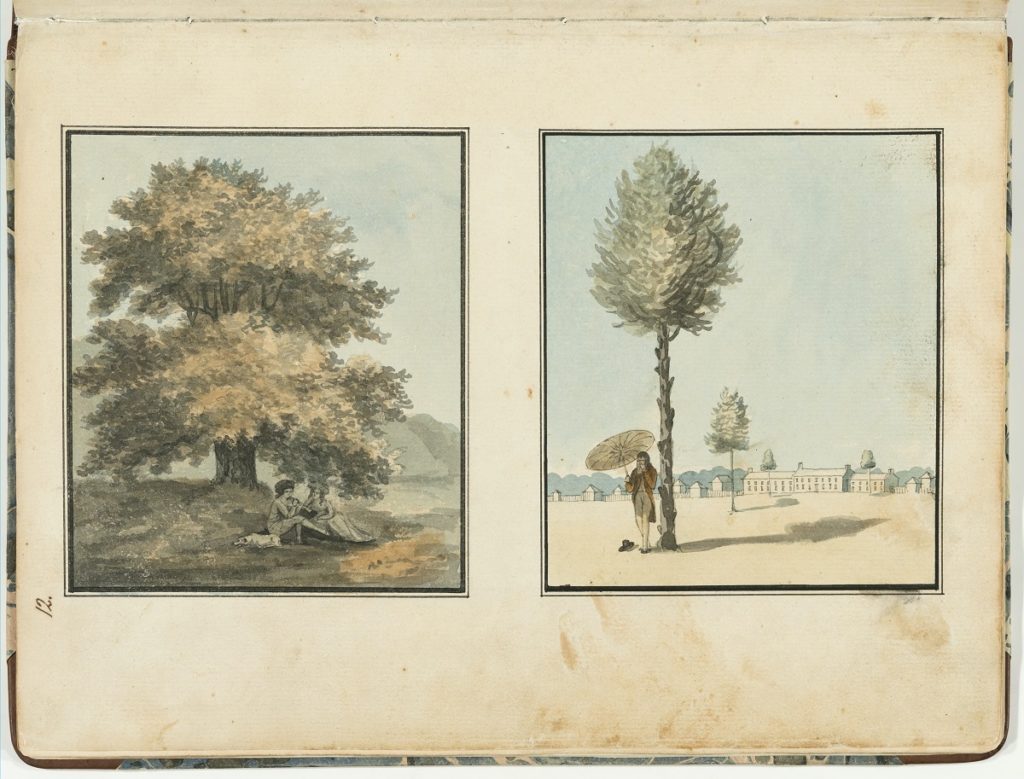
Nor is Hopkinson’s “Letter” the only example of trees displacing subaltern humans as subjects of sympathy and admiration. In 1795, the British-born architect Benjamin Henry Latrobe wrote and illustrated An Essay on Landscape, a manuscript landscape drawing manual. A work that draws heavily on Picturesque principles, the early pages of the second volume lay out the stark difference between the aesthetics of Latrobe’s country of origin and that of his adopted nation (Fig. 14). Latrobe observes that the “cultivated” American landscape made it appear “as if the War waged by Agriculture against our forests, had been a War of extermination, and that, while we combated the Nation of trees in our Woods, we had ungenerously extended our enmity to the individuals about our houses.” Latrobe’s language—a “War of extermination” against a “Nation” inhabiting the Woods—conjures up the spectre of another, related decimation. A simple substitution—”Indians” for “trees”—and we have a shadow statement, an eerily apt description of European colonists’ behavior toward indigenous peoples. Latrobe’s defensive utterance goes further. “For my own part,” he confides, “I have a particular attachment to trees. Considering them as beings endowed with sensation—in which opinion I am not at all singular or original—I feel pleasure in preserving as many as possible from pain, mutilation, and death.”[40] With this observation and disavowal, Latrobe sought to distance himself from another class of American by underscoring his enlightened recognition of trees as sensate, subject-like beings.[41]
However, the attitude of elite Americans towards trees may not have been so different, ultimately, from their attitude towards human subalterns. If trees were indeed, as Latrobe argued, “beings endowed with sensation,” and were furthermore, as Hopkinson’s column claimed, beings whose agency and consciousness extended past the end of their vegetal life, veneer objects were attended by a deep violence—even if that violence was not consciously recognized by eighteenth-century viewers. In light of these statements, veneer surfaces should be understood as products of a cruel vivisection. The slicing of veneers, especially in the volume that defined early American furniture production, lay bare the interior of the tree for humans’ optical delectation. Returning once again to the Davey desk (see Fig. 1a), the oval panels and delicate stringing take on an additional charge, underscoring the way in which the slicing of veneers transforms a complex, three-dimensional entity into bounded, two-dimensional form. For all that these decorative devices frame the beauty of the figured mahogany, it is they, and not the mahogany itself, that determines the shape and nature of its display. And while this violence always attends veneer, it was heightened in the early American context, where veneer slices sat like so many taxidermied trophies inside homes, of both elite and middling-class persons, whose very existence was supported by the wholesale destruction of both proximate and distant forests.
At the same time, one wonders whether the radical ideas voiced by Hopkinson and Latrobe could even have been thought without the presence of figured veneers and the discourses that fueled their valuation. Over the course of the late eighteenth century, Picturesque and natural-historical interest in trees’ intimate, even reciprocal, relationship with their environments had found objects of interest not only in trees’ external forms, but also in their internal grain, whose regular and irregular patterns offered glimpses into each individual tree’s storied past. In trees, Anglo-Americans intuited something like the ecology or interconnectedness of all things, both living and nonliving.
Furthermore, even relatively simple uses of veneer, like the paired mahogany ovals in the Davey desk, offer a glimpse into the complex relationality that exists both within and between entities. The veneers sliced from a given flitch are formally related to each other, having originally been part of a single mass; but they are also unique, because of that mass’s irregular structure. Especially when they employed a series of veneers sliced consecutively from the same flitch (see Figs. 8-9), cabinetmakers underscored both the wonderful variety and the deep-rooted similarity that exists among these surfaces: to borrow a phrase from Hopkinson’s talking column, cabinetmakers demonstrated, again and again, “that all the exhibitions in nature are so many different modifications and manifestations of one original essence or principle.”[42]
This, then, is the crux of veneer’s paradox in America — that even as it was shadowed by the violent destruction of the environment, it may have contributed to a nascent apprehension of the ways in which all of the different beings of an environment are related and interlinked. During the last few decades of the eighteenth century, Anglo-Americans came to appreciate the particular beauty of natural entities and the ways in which that particularity, or what Gilpin called adventitiousness, was shaped by the specific environment and circumstances through which an entity has lived. They grappled with this complex material archive, shifting between desires to decipher or analyze it, to take advantage of it, and simply to wonder at it. Early Americans in particular filled their homes with material artifacts that demonstrate their appreciation of some trees, while they simultaneously effected a massive destruction of other trees. In this regard figured wood, and especially its use in veneer furniture, illuminates the rich, contradictory, and troubled relationship that Americans held with nature in the early years of their nation’s formation.
Jennifer Y. Chuong is a Junior Fellow
in the Harvard Society of Fellows and is completing a dissertation titled
“The Nature of Surfaces in Early America”
[1] This essay originated in a paper that I presented on the “Things Change” panel chaired by Wendy Bellion and Kristel Smentek at HECAA at 25. I thank both of them, and members of the audience, for their generous and thoughtful engagement with this work. I am also grateful to Amy Freund for the invitation to develop the paper for publication in this special issue of Journal18; and to the two anonymous reviewers, Jennifer L. Roberts, Ethan Lasser, Matthew Hunter, Elizabeth Eager, Nicholas Robbins, and Aleksandr Bierig for their insightful comments on earlier and related drafts of this material.
[2] Pliny the Elder, The Natural History of Pliny, ed. John Bostock and Henry Riley (London: H.G. Bohn, 1855-1857), vol. 3, 429.
[3] This is true even in sympathetic accounts of neoclassical veneer, like that of Jennifer Anderson. Anderson, Mahogany: The Costs of Luxury in Early America (Cambridge, MA: Harvard University Press, 2012), 187-188.
[4] For accounts of veneer’s transformation under industrialization, see Clive Edwards, “A History of Veneer Cutting,” in Antique Furniture Restoration and Conservation Guide: The 2008 BAFRA Directory (Peterborough, Cambridgeshire, UK: British Antique Furniture Restorers’ Association, 2008), 45–50, esp. 45; Edwards, Victorian Furniture: Technology and Design (New York: Manchester University Press, 1993), 32-34; and Adrian Forty, Objects of Desire (New York, NY: Pantheon Books, 1986), 56-57. While this essay focuses on the aesthetic motivations behind veneer in the late eighteenth and early nineteenth centuries, it is important to note that metallurgical developments, particularly that of crucible (or cast) steel, likely enabled the sawing of larger, thinner veneers, and consequently, the kinds of decorative surfaces that I describe.
[5] See Thomas Sheraton, The Cabinet Dictionary (London: W. Smith, 1803), 328; and Cabinetmakers’ London Book of Prices (London: Sold at the White Swan, and the Black Boy, 1788; London: W. Brown and A. O’Neil, 1793; London: Printed by C. Barber for the London Society of Cabinet-Makers, 1803), The Journeymen Cabinet and Chair-Makers’ Philadelphia Book of Prices (Philadelphia: Printed by Ormrod and Conrad, 1795; Philadelphia: Printed for the Society, 1811), The Journeymen Cabinet and Chairmakers’ New-York Book of Prices (New York: Printed by T. & J. Swords, 1796), The New York Book of Prices for Cabinet and Chair Work (New York: Southwick and Crooker, 1802), and The New-York Revised Prices for Manufacturing Cabinet and Chair Work (New York: Printed by Southwick and Pelsue, 1810).
[6] For British timber shortage and eighteenth-century responses, see Robert Greenhalgh Albion, Forests and Sea Power: The Timber Problem of the Royal Navy, 1652-1862 (Annapolis, MD: Naval Institute Press, 2000); and Blanche Henrey, British Botanical and Horticultural Literature Before 1800 (New York: Oxford University Press, 1975), 644-647.
[7] The classic study of early European settlers’ relationship to North American forests is Roderick Nash, Wilderness and the American Mind, 5th ed. (New Haven: Yale University Press, 2014), 23-43. For the technological impact of wood’s plentiful supply in America, see Brooke Hindle, “Introduction: The Span of the Wooden Age,” in America’s Wooden Age: Aspects of its Early Technology, ed. Hindle (Tarrytown, NY: Sleepy Hollow Restorations, 1975), 3-10.
[8] I use the eighteenth-century adjective “plain” to refer to the homogenous sections of wood, free of knots, blemishes, and other irregularities, which are primarily harvested from the long, straight section of the trunk. Today we would more commonly describe these as “clearwood.”
[9] Relatedly, such objects have also garnered recent scholarly attention because they lend themselves to a new-again narrative about material agency. From Baxandall’s discussion of lime wood sculpture to Timothy Ingold’s interest in David Nash’s sculpture, some of the most sophisticated thinking about materiality has centered on the ways in which materials elicit specific physical behaviors from human makers. Baxandall, The Limewood Sculptors of Renaissance Germany (New Haven: Yale University Press, 1980); and Ingold, “Materials Against Materiality,” in Being Alive : Essays on Movement, Knowledge and Description (London; New York: Routledge, 2011), 27. For the relationship between “making” and truth to material, see Elizabeth Rankin and Robert Hodgins, “The Concept of Truth to Material,” de arte 14, 23 (1979), 3.
[10] I make this point not to denigrate carving and its ideation of wood, but rather to suggest that a material possesses more than one “truth” to exhibit, depending both on its specific properties (plain versus figured mahogany, for example) and what Michael Baxandall terms the “brief” of a given cultural moment. For the distinction between the objective “properties” of materials and the subjective “qualities” valued by a given maker or culture, see David Pye, The Nature and Art of Workmanship, revised ed. (Bethel, CT: Cambium Press, 1995), 86-90; for briefs, see Baxandall, Patterns of Intention: On the Historical Explanation of Pictures (New Haven: Yale University Press, 1985), 43-50.
[11] David Beckford, quoted in Les Cizek and Norma Watkins, “The Age of Mahogany,” in In the 18th-Century Style: Building Furniture Inspired By the Classical Tradition, ed. The Editors of Fine Woodworking (Newtown, CT: Taunton Press, 2003), 41. Eighteenth-century commentators were not so far-reaching in their comparisons, but they too noted that mahogany was “soft like deal” and “easily worked.” See, respectively, Henry Barham, Hortus Americanus [c. 1720] (Kingston, Jamaica, 1794), 37; and Patrick Browne, The Civil and Natural History of Jamaica (London, 1789), 158.
[12] William Dunlap, History of the Rise and Progress of the Arts of Design in the United States (New York, 1834), vol. 1, 315. Rush’s statement would have been especially useful to Dunlap’s nationalistic project, echoing as it does Vasari’s admiring characterization of Michelangelo’s carving process as a negative one. Giorgio Top of Form
Vasari, Lives of the Painters, Sculptors, and Architects, transl. by Gaston du C. De Vere (London: Everyman’s Library, 1996), vol. 2, 738, 746.Bottom of Form
[13] Sir Joshua Reynolds, “No. 82, 10 November 1759, ” republished in The Idler, new ed. (London: Printed for Cadell and Davies, 1816), 330. In the context of this essay’s larger argument, it is worth noting that, by the time he delivered Discourse XIII (1786), Reynolds seems to have developed a cautious preference for variety and intricacy over uniformity. See Peter J. De Voogd, “Laurence Sterne, the Marbled Page, and ‘the Use of Accidents,’” Word & Image 1:3 (1985), 279-287, esp. 279-281.
[14] Lorraine Daston and Peter Galison, Objectivity (New York: Zone Books, 2007), 60.
[15] In its broad contours, this interest is related to an older, broader interest in climate’s influence on living beings. However, the scale of the interest expressed by the authors cited in this essay, which attends to the impact of a single thunderstorm on an individual tree (for example), rather than the sustained effects of regional climates on local species, is distinctive and deserves further study.
[16] Edward Long, The History of Jamaica (London: Printed for T. Lowndes, 1774), vol. 3, 843-844.
[17] Gilpin, Remarks on Forest Scenery (London: Printed for R. Blamire, 1791), 2.
[18] Gilpin, Remarks on Forest Scenery, 4
[19] Gilpin, Remarks on Forest Scenery, 12, 36, 56.
[20] Gilpin, Remarks on Forest Scenery, 60. Gilpin here is referencing Pliny the Elder’s Natural History, but the choice of the word “excrescence” is his own.
[21] In this essay I focus on mahogany both because of its ubiquity and because the extreme homogeneity of plain mahogany forms a clear contrast with its figured counterpart. However, it should be noted that many other species of figured wood, both imported and domestic, were used for veneer furniture in early America. For example, see the descriptions of curled maple and the common European elm, and their use in cabinetmaking in Fraņcois André Michaux, The North American Sylva (Philadelphia: Sold by Thomas Dobson—Solomon Conrad; Paris, Printed by C. d’Hautel, 1817-[1819]), vol. 1, 220; vol. 3, 94.
[22] See Adam Bowett, “The English Mahogany Trade 1700-1793” (PhD diss., Brunel University, 1996), 100.
[23] For details regarding the mahogany trade, see Long, The History of Jamaica, vol. 3, 843-844; Chaloner and Fleming, The Mahogany Tree (Liverpool, 1850); Bowett, “The English Mahogany Trade 1700-93,” 193-226; Anderson, Mahogany, esp. 156-183; and Daniel Finamore, “Furnishing the Craftsman: Slaves and Sailors in the Mahogany Trade,” American Furniture (2008), 61-87.
[24] Though my focus here is on the irregular beauty of figured veneers, it is important to remember that in a preindustrial era, the production of symmetry and regularity was itself virtuosic. See Mimi Hellman, “The Joy of Sets: The Uses of Seriality in the French Interior,” in Furnishing the Eighteenth Century: What Furniture Can Tell Us About the European and American Past, ed. Dena Goodman and Kathryn Norberg (New York: Routledge, 2006), 129-153.
[25] Gilpin, Remarks on Forest Scenery, 173.
[26] For the early history of tree ring analysis, see R.A. Studhalter, “Tree Growth I. Some Historical Chapters,” Botanical Review 21:1/3, Tree Growth (1955), 16.
[27] Studhalter, “Tree Growth I,” 55.
[28] Alexander Twining, “On the Growth of Timber,” in The American Journal of Science and Arts, ed. Benjamin Silliman (New Haven, 1833), 392. While the eighteenth-century interest in the archival character of wood-grain was new, Ethan Lasser suggests that a lexical and conceptual correspondence between cabinetry veneers and botanical specimens dates back to the seventeenth century. Lasser, “Figures in the Grain: The Enlightenment of Anglo-American Furniture, 1660-1800” (PhD diss., Yale University, 2008), 77.
[29] Twining, “On the Growth of Timber,” 391.
[30] Michaux, The North American Sylva, vol. 1, 220-221.
[31] Michaux, The North American Sylva, vol. 3, 94; vol. 2, 227.
[32] Gilpin, Remarks on Forest Scenery, 35.
[33] Paul A. Elliott, C. Watkins, and Stephen Daniels, The British Arboretum : Trees, Science and Culture in the Nineteenth Century (London: Pickering & Chatto, 2011), 11. See also Stephen Daniels, “The Political Iconography of Woodland in Later Georgian England,” in The Iconography of Landscape : Essays on the Symbolic Representation, Design, and Use of Past Environments, ed. Denis E. Cosgrove and Daniels (New York: Cambridge University Press, 1988); and Irene Fizer, “A ‘Passion for Dead Leaves’: Animated Landscapes and Static Canvases in Sense and Sensibility,” South Atlantic Review 76:1 (2011), 53-72. For the cultural valuation of trees across the long eighteenth century, see Laura Auricchio, Elizabeth Heckendorn Cook, and Giulia Pacini, eds., Invaluable Trees: Cultures of Nature, 1660-1830 (Oxford: Voltaire Foundation, 2012).
[34] In addition to Hindle (n. 5), see also Eric Rutkow, American Canopy: The Role of Trees in the Shaping of a Nation (New York: Scribner, 2012), 1-70, and Thomas R. Cox, This Well-Wooded Land: Americans and Their Forests From Colonial Times to the Present (Lincoln: University of Nebraska Press, 1985), 3-73.
[35] For an overview of American expansion and its impact on forests in this period, see Michael Williams, Americans and their Forests: A Historical Geography (Cambridge, UK: Cambridge University Press, 1989), 53-110.
[36] Silvester [Francis Hopkinson], “For the Pennsylvania Gazette: To the Printers,” Pennsylvania Gazette 21 (August 1782), [1].
[37] Laura Turner Igoe, “’Appropriate in a Sylvan State’: William Rush’s Self-Portrait and Environmental Transformation,” American Art 28, 1 (2014): 96. For the equation of humans and plants in early America, see also Alexander Nemerov, The Body of Raphaelle Peale: Still Life and Selfhood, 1812-1824 (Berkeley: University of California Press, 2001), 17-20 and 116-122.
[38] Wendy Bellion, “Mast Trees, Liberty Poles, and the Politics of Scale in Late Colonial New York,” in Scale, ed. Jennifer L. Roberts (Chicago: Terra Foundation for American Art, 2016), esp. 226-227 and 236.
[39] [Hopkinson], “For the Pennsylvania Gazette,” [1].
[40] Benjamin Henry Latrobe and Edward C. Carter (ed.), The Virginia Journals of Benjamin Henry Latrobe, 1795-1799 (New Haven: Published for the Maryland Historical Society by Yale University Press, 1977), 500. For an astute reading of the intersection of proto-ecological consciousness and social conservatism among elite Americans, see Jane Kamensky, “‘In These Contrasted Climes, How Chang’d the Scene’: Progress, Declension, and Balance in the Landscapes of Timothy Dwight,” The New England Quarterly 63, 1 (1990): 80–108, esp. 108.
[41] The psychology of Latrobe’s statement is not easy to unravel. In psychoanalysis, this kind of word substitution is known as a “substitute formation” or “substitutive formation.” On top of this (or as a part of it), Latrobe engages in a form of reaction formation, emphasizing a socially-positive impulse (one of peaceableness, fellowship, and recognition) in order to repress a socially-unacceptable impulse of aggression, enmity, and refusal. For the linguistic basis of substitutive formation, see Siegfried Zepf, “Repression and Substitutive Formation: The Relationship Between Freud’s Concepts Reconsidered,” Psychoanalytic Review 99, 3 (2012), esp. 410-414. I thank Levi Prombaum for directing me to this article and helping me think through this issue.
[42] [Hopkinson], “For the Pennsylvania Gazette,” [2].
Cite this article as: Jennifer Y. Chuong, “The Nature of American Veneer Furniture, circa 1790-1810,” Journal18 Issue 9 Field Notes (Spring 2020), https://www.journal18.org/4733.
Licence: CC BY-NC
Journal18 is published under a Creative Commons CC BY-NC International 4.0 license. Use of any content published in Journal18 must be for non-commercial purposes and appropriate credit must be given to the author of the content. Details for appropriate citation appear above.
